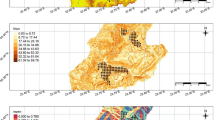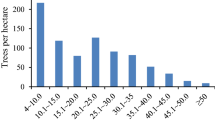Abstract
The study area was located in Liangshui Natural Reserve. Xaoxing’an Mountains. Northeastern China Korean pine forests are the typical forest ecosystem and landscapes in this region. It is a high degrees of spatial and temporal heterogeneity at different scales, which effected on landscape pattern and processes. In this paper we used the data of 144 plots and semivariogram to analyze spatial heterogeneity of old growth forests of Korean pine in landscape level. Model for forest variations by isotropic semivariogram is linear with sill. The spatial heterogeneity is dependent on scales and directions in Korean pine forests. Patterns of forest types in space were resulted from complex interactions between physical and biological forces. We used 20 metres for interpolation interval to estimate the values of unsampled area. Comparing the results with field data, block kriging and mapping are an effective techniques to simulate landscape pattern.
Similar content being viewed by others
References
Bartrell, S.M. et al. 1991. A spatial-temporal model of nitrogen dynamics in a deciduous forest watershed. In quantitative methods in landscape ecology (eds by Turner et al). Springer-Verlage, New York, USA.
Burrough, P.A. 1983. Multiscale sources of spatial variation in soil. I. The application of fractal concepts to nested levels of soil variation. Journal of Soil Science 34:577–597.
Burrough, P.A. 1986. Principles of geographical information systems for land resources assessment. Clarendon Press, Oxford, UK
Burrough, P.A. 1987. Spatial aspects of ecological data. Pages 89–125 in R.H. Jongman et al editors. Data analysis in community and landscape ecology. Pudoc Wageningen, The Netherlands.
Chen Dake et al. 1982. Ecological Review of Korean pine forests. J. of Northeast forestry Univ. 9(2):1–18.
Cressie, N.A.C. 1991. Statistics for spatial data. Wiley, New York.
Forman, R.T. et al. 1986. Landscape Ecology, New York, Wiley.
Fortin, L. 1988. A general model of populations in patchy habitats. Applied Mathematics and Computation 27: 53–66.
Gardner, R.H. et al 1987. Neutral models for the analysis of broad-scale landscape pattern. Landscape Ecol. 1: 19–28.
Gardner, R.H. et al 1991. Pattern. process, and predictability: The use of neutal models for landscape analysis. In Quantitative methods in landscape ecology (eds by Turner et al) Spring-Verlag. New York.
Isaaks, E.H. et al. 1989. An introduction to applied geostatistics. Oxford University Press, New York New York, USA.
Journel, A et al. 1987. Mining geostatistics. Academic Press. London, UK.
Kirge, D.G. 1966. Two dimensional weighted moving average trend surfaces for ore-evaluation. J. of South African Inst. Min. Metal. 66:13–38.
Kolasa, J. et al. 1991. Ecological heterogeneity. Springer-Verlag. New York, USA.
Legendre, P. et al. 1989. Spatial pattern and ecological analysis. Vegentatio. 80:107–138.
Levin, S.A. et al. 1989. Dynamical models of ecosystems and epidemics. Future Generation Computer Systems 5:265–274.
Li, H. et al. 1988. Landscape ecology: a new conceptual framework in ecology Advances in Ecology(Chines). 5(1):23–33.
Li, H. et al. 1995. On definition and quantification of heterogeneity. Oikos 73(2):280–284.
Li, J. et al. 1993. Forests of Heilongjiang. Forestry Press. Beijing. China.
Matheron, G. 1963. Principles of geostatistics. Economic Geology 58:1246–1266.
Milne, B.T. 1988. Measuring the fractal dimension of landscape. Appl. Math. Comput. 27:67–79.
O’Neill, R.V. et al. 1988. Indices of landscape pattern. Landscape Ecology, 1:153–162.
Palmer, M.W. 1988. Fractal geometry: a toll for describing spatial patterns of plant communities. Vegetation 75:91–102.
Risser, P.G. 1987. Landscape Ecology: state-of-art. In landscape heterogeneity and disturbance. New York: Springer-Verlag, 3–14.
Robertson, G.P. 1987. Geostatistics in ecology: interpolating with known variance. Ecology, 68:744–748.
Robertson, G.P. et al. 1988. Spatial variability in a successional plant community: patterns of nitrogen availability. Ecology 69:1517–1524.
Romme, W.H. 1982. Fir and landscape diversity in subaloine forests of Yellow stone National Park. Ecological Monographs, 52:199–221.
Rossi, R.E. et al. 1992. Geostatistical tools for modeling and interpreting ecological spatial dependence. Ecological Monographs. 62:277–314.
Sklar, F.H. et al. 1991. The development of spatial simulation modeling for landscape ecology: A review and prognosis. In Quantitative methods in landscape ecology (eds by Turner et al) Spring-Verlag, New York.
Trangmar, B.B. et al. 1985. Application of geostatistics to spatial studies of soil properties. Advanced Agronomy 38:44–94.
Turner, M.G. 1987. Landscape heterogeneity and disturbance. Springer-Verlag, New York, New York, USA.
Turner, M.G. 1989. Landscape Ecology: The effect of pattern on process. Annu. Rev. Ecol. Syet. 20:171–197.
Turner, M.G. et al. 1991. Quantitative methods in landscape ecology. The analysis and interpretation of landscape heterogeneity. Springer-Verlag, New York, USA.
Webster, R. 1985. Quantitative spatial analysis of soil in the field. Advance in Soil Science 3:1–70.
Wiens. J.A. 1988. The analysis of landscape patterns: interdisciplinary seminar in ecology. Colorado State Univ.
Wang, Y. et al. 1996. Korean Pine Forests. Northeasi Forestry University Press, Harbin. China.
Wang, Z.Q. et al. 1997. Quantification of spatial heterogeneity in old growth forests of korean pine. J. of Forestry Research. 8(2):65–69.
Author information
Authors and Affiliations
Additional information
This project is supported by Huo Yingdong Science fundation.
Responsible Editor: Chai Ruihai
Rights and permissions
About this article
Cite this article
Zhengquan, W., Yandong, Z., Qingcheng, W. et al. Simulation of landscape pattern of old growth forests of Korean pine by block kriging. Journal of Forestry Research 8, 131–136 (1997). https://doi.org/10.1007/BF02855404
Issue Date:
DOI: https://doi.org/10.1007/BF02855404




